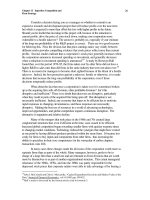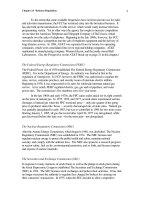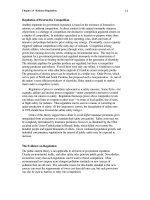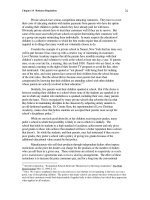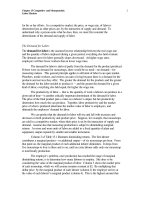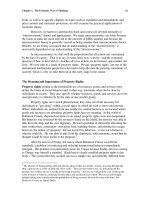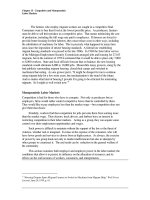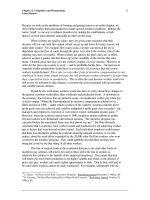Microeconomics for MBAs 52
Bạn đang xem bản rút gọn của tài liệu. Xem và tải ngay bản đầy đủ của tài liệu tại đây (83.57 KB, 10 trang )
Chapter 15 Competitive and Monopsonistic
Labor Markets
22
Because we took up the problems of forming and paying teams in an earlier chapter, we
only remind readers that team production creates special incentive problems. Making the
teams “small” is one way to enhance incentives by making the contributions, or lack
thereof, of each team member noticeable to others on the team.
When workers are paid by salary, they are given some assurance that their
incomes will not vary with firm output, which can go up and down for many reasons, not
under their control. For example, how many socks a worker can stitch at the toe is
dependent upon the flow of socks through the plant, over which the workers who do the
stitching may have no control. When workers are paid by the piece, they are, in effect,
asked to assume a greater risk that shows up in the variability of the income they take
home. Granted, piece rate may give the workers a higher average income. However, in
order for the piece rate system to work -- and be profitable for the firm -- the increase in
expected worker productivity would have to exceed the risk premium that risk averse
workers would demand. Piece rate (or any other form of incentive compensation) is not
employed in many firms simply because the risk premium workers demand is greater than
their expected increase in productivity. This is often the case because workers tend to be
risk averse (or reluctant to take chances, or assume the costs associated with an uncertain
and variable income stream).
If paid by the work done, workers would also have to worry about how changes in
the general economy would affect their workloads and production levels. A downturn in
the economy, due to forces that are global in scope, can undermine worker pay when pay
is tied to output. When Du Pont introduced its incentive compensation scheme for its
fibers division in 1988 -- under which a portion of the workers’ incomes could be lost if
profit goals were not achieved and could be multiplied if profit goals were exceeded – the
managers and employees expected, or were told to expect, substantial income gains.
14
However, when the economy turned sour in 1990, employee morale suffered as profits
fell and workers were threatened with reduced incomes. The incentive program was
cancelled before the announced three-year trial period was up.
15
Du Pont obviously
concluded that it could buy back worker morale and production by not subjecting worker
pay to factors that were beyond worker control. Each individual employee could reason
that there was absolutely nothing he could do about the national economy or, for that
matter, about the work effort expended by the 20,000 other Du Pont workers who were
covered by the incentive program. They could rightfully fear that their incomes were
being put at risk by the free riding of all other workers.
This line of analysis leads to the conclusion that piece-rate (and other forms of
incentive) pay schemes will tend to be used in firms where the risk to workers is
relatively low (relative to the benefits of the improved incentives). This means that they
will tend to be used where production is not highly variable and where, in the absence of
piece-rate pay, workers can easily exploit opportunities to shirk. That is, they will tend to
be used where workers cannot be easily monitored. For example, salespeople who are
14
L. Hayes, “All Eyes on Du Pont’s Incentive Program,” Wall Street Journal, December 5, 1988, p. B1.
15
R. Koening, “Du Pont Plan Linking Pay to Fibers Profit Unravels,” Wall Street Journal, October 25,
1990, p. B1.
Chapter 15 Competitive and Monopsonistic
Labor Markets
23
always on the road (which necessarily means that no one at the home office knows much
about what they do on a daily basis) will tend to be paid, at least in part, by the “piece,”
in some form or another, say, by the sale.
Piece-rate pay systems may also be avoided because employers are likely to be in
a better position to assume the risk of production variability than their employees are.
This is because much of the variability in the output of individual workers will be
“smoothed out” within a whole group of employees. When one worker’s output is down,
then another worker’s output will be up. Workers will, in effect, be able to buy
themselves out of the risk. If each of the workers sees the risk cost of the piece-rate
system at $500 and the employer sees the risk cost at $100, then each worker can agree to
give up, say, $110 in pay for the rights to a constant income. The worker gains, on
balance, $390 in non-money income ($500 in risk cost reduction minus the $110
reduction in money wages). The employer gives up the piece-rate system simply because
he or she can make a profit -- $10 in this example -- off each worker ($110 reduction in
worker money wages minus the $100 increase in risk cost). One would therefore expect,
other things equal, piece-rate pay schemes would be more prevalent in “small” firms
than in “large” ones. Large employers are more likely to be able to smooth out the
variability.
Also, piece-rate pay systems can only be used when and where employers can
make credible commitments to their workers to abide by the pay system that they
establish and not to cut the rate in the piece-rate when the desired results are achieved.
Unfortunately, all too often managers are unable to make the credible commitment for the
same reason that they might find, in theory, the piece-rate system to be an attractive way
(in terms of worker productivity and firm profits) to pay workers. The basic problem is
that both workers and managers have incentives to engage in opportunistic behavior to
the detriment of the other group.
Managers understand that many workers have a natural inclination to shirk their
responsibilities, to loaf on the job and misuse and abuse company resources with the
intent of padding their own pockets. Managers also know that if they tie their workers’
pay to output, then output may be expected to expand. Fewer workers will exploit their
positions and loaf on the job. At the same time, the workers can reason that incentives
also matter to managers. Like workers, managers are not always angels (and are
sometimes outright devils, just like their workers) and can be expected, to one degree or
another, to exploit their positions, achieving greater personal and firm gains at the
expense of their workers.
Hence, workers can reason that if they respond to the incentives built into the
piece-rate system and produce more for more pay, then managers can change the deal.
The managers can simply raise the number of pieces that the workers must produce in
order to get the previously established pay, or managers can simply dump what will then
be excess workers.
To clarify this point, suppose a worker is initially paid $500 a week, and during
the course of the typical week, he or she produces 100 pieces -- for an average pay of $5
per piece. Management figures that the worker is spending some time goofing off on the
Chapter 15 Competitive and Monopsonistic
Labor Markets
24
job and that the worker’s output can be raised if he or she is paid $5 for each piece
produced.
If the worker responds by increasing his output to 150 pieces, the management
can simply lower the rate to $3.50 per piece, which would give the worker $525 a week
and would mean that the firm would take the overwhelming share of the gains from the
worker’s -- not management’s -- greater efforts. The worker would, in effect, be working
harder and more diligently with little to show for what he or she has done. By heeding
the piece-rate incentive, the worker could be inadvertently establishing a higher
production standard.
These threats are real. Managers at a General Motors panel stamping plant in
Flint, Michigan announced that the company would allow workers to leave after they had
satisfied daily production targets. Workers were soon leaving by noon. Management
responded by increasing production targets. The result was a bitter workforce.
16
So, one reason piece-rate systems aren’t more widely used is that the systems can
be abused by managers, which means that workers will not buy into them at reasonable
rates of pay.
Another way of explaining the lack of use of piece-rate pay is that they often
don’t work as might be expected. Incentives still matter. The problem is that the much
talked-about incentives are not there, or workers don’t believe they are there. And
workers don’t believe the incentives are present because they don’t -- or can’t -- believe
that their managers will resist the temptation to gain at their -- the workers’ -- expense.
Managers are unable to make what we have, in other contexts, called a credible
commitment (or a position on which workers can rely), meaning they have not been able
to convince their workers that they will not take advantage of them (just as the workers
may have been taking advantage of their managers).
Indeed, the piece-rate system can have the exact opposite effect of the one
intended. We have noted that workers can reason that their managers will increase the
output demands if they produce more for any given rate. However, the implied
relationship between output and production demands should also be expected to run the
other way: That is, the workers can reason that if managers will raise the production
requirements when they produce more in response to any established rate, then managers
should be willing to lower the production requirements when the workers lower their
production after the piece-rate system is established. Hence, the establishment of the
piece-rate system can lead to a reduction in output as workers cut back on production.
The purpose of the incentive pay may be to increase production, but the result can be to
induce lower production standards for the same rate of pay. The workers’ expectation
can be that the rate of pay will be raised.
How? Suppose that the worker responds to the rate of $5 per piece by actually
cutting back his or her total production from 100 to 75 pieces per week. Then
management might be expected to increase the rate to, say, $6.50 per piece, leaving the
16
See Benjamin Klein, Robert Crawford, and Armen Alchian, “Vertical Integration, Appropriable Rents,
and the Competitive Contracting Process,” Journal of Law and Economics, vol. 21 (1978), pp. 297-326.
Chapter 15 Competitive and Monopsonistic
Labor Markets
25
worker with $487.50 for the week, or a 2.5 percent reduction in pay for a 25 percent
reduction in effort.
The lesson of this discussion is not that piece-rate pay incentives can’t work.
Rather, the lesson is that getting them right can be tricky. Managers must convincingly
commit themselves to holding to the established piece rate and not exploiting the workers.
The best way for managers to be believable is to create a history of living up to their
commitments, which means creating a valuable reputation with their workers.
Lincoln Electric, a major producer of arc-welding equipment in Cleveland, makes
heavy use of piece-rate pay. The system has resulted in a doubling of worker productivity
since 1945 and continues to be successful for several reasons:
• First, the company has a target rate of return for shareholders, with deviations
from that target either adding to or subtracting from their workers’ year-end
bonuses, with the bonus often amounting to 100 percent of workers’ base pay.
• Second, employees largely own the firm, a fact that reduces the likelihood that
piece rates will be changed.
• Third, management understands the need for credible commitments. According
to one manager, “When we set a piecework price, that price cannot be changed
just because, in management's opinion, the worker is making too much money . .
.. Piecework prices can only be changed when management has made a change in
the method of doing that particular job and under no other conditions. If this is
not carried out 100 percent, piecework cannot work."
17
• Fourth, Lincoln pursues a permanent employment policy. Permanent employees
are guaranteed only 75 percent of normal hours, and management can move
workers into different jobs in response to demand changes. Also, workers have
agreed to mandatory overtime when demand is high (meaning that the firm
doesn't have to hire workers in peak demand periods). In other words, workers
and management have agreed to share some of the risk.
• Fifth, to combat quality problems, each unit produced is stenciled with the initials
of the workers who produced it. If a unit fails after delivery because of flaws in
production, the responsible workers can lose as much as 10 percent of their annual
bonus.
• Sixth, large inventories are maintained to smooth out differences in the production
rates of different workers.
Does this mean that managers can never raise the production standard for any
given pay rate? Of course not. Workers should only be concerned if the standard is
changed because of something they -- the workers -- did. If management in some way
increases the productivity of workers (for example, introduces computerized equipment
or rearranges the flow of the materials through the plant), independent of how much
17
As quoted in Gary J. Miller, Managerial Dilemmas: The Political Economy of Hierarchy (New York:
Cambridge University Press, 1992), p. 117.
Chapter 15 Competitive and Monopsonistic
Labor Markets
26
effort workers apply, then the standard can be raised. Workers should not object. They
are still getting their value for their effort. They are not being made worse off. What
managers must avoid doing is changing the foundations of the work and then taking more
in terms of a lower pay rate than they are due, which effectively means violating the
contract or commitment with their workers.
As the Lincoln Electric manager notes: “Piecework prices can only be changed
when management has made a change in the method of doing that particular job and
under no other conditions.”
18
Otherwise, piece-rate pay can have the exact opposite
effect of the one intended.
Two-Part Pay
There are innumerable ways of paying people to encourage performance. The two-part
pay contract -- salary plus commission -- is obviously a compromise between straight
salary and straight commission pay structures. For example, a worker for a job
placement service can be paid a salary of $1,500 a month, plus 10 percent of the fees
received for any placement. If the recruiter can be expected to place one worker a month
and the placement fee is $10,000, the worker’s expected monthly income is $2,500
($1,500 plus 10 percent of $10,000).
This form of payment can be mutually attractive to the placement firm and its
recruiters because it accomplishes a couple of important objectives. First, the system can
be a way by which workers and their employers can share the risks to reflect the way the
actual placements depend on the actions of both the workers and their employers. While
each worker understands that his or her placements are greatly affected by how hard and
smart he or she personally works, each also knows that often, to a nontrivial degree, the
placements are related to what all other workers and the employer do. Worker income is
dependent on, for example, how much the employer advertises, seeks to maintain a good
image for the firm, and develops the right incentives for all workers to apply themselves.
Workers have an interest in everyone in the firm working as a team, just as the
employer does. Productive work by all can increase firm output, worker pay, and job
security. As a consequence, while each worker may, in one sense, “prefer” all income in
the form of a guaranteed fixed monthly check, the worker also has an interest in
commission pay -- if everyone else is paid commission and if perverse incentives are
avoided. Often each worker’s income is dependent upon how hard others work.
Individual recruiters, to carry forward our example, often benefit from the attempts of
other recruiters to make successful, quality placements. Such efforts can spread and
enhance the name of the firm, making it easier for all other recruiters to make
placements.
Hence, a pay system that is based, to a degree, on commission can raise the
incomes of all recruiters. Put another way, to the extent that one worker’s income is
18
Ibid.
